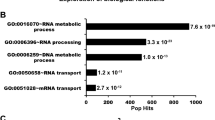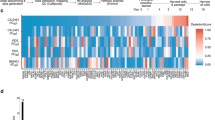Abstract
Guanine-rich DNA sequences that can adopt non–Watson-Crick structures in vitro are prevalent in the human genome. Whether such structures normally exist in mammalian cells has, however, been the subject of active research for decades. Here we show that the G-quadruplex–interacting drug pyridostatin promotes growth arrest in human cancer cells by inducing replication- and transcription-dependent DNA damage. A chromatin immunoprecipitation sequencing analysis of the DNA damage marker γH2AX provided the genome-wide distribution of pyridostatin-induced sites of damage and revealed that pyridostatin targets gene bodies containing clusters of sequences with a propensity for G-quadruplex formation. As a result, pyridostatin modulated the expression of these genes, including the proto-oncogene SRC. We observed that pyridostatin reduced SRC protein abundance and SRC-dependent cellular motility in human breast cancer cells, validating SRC as a target of this drug. Our unbiased approach to define genomic sites of action for a drug establishes a framework for discovering functional DNA-drug interactions.
This is a preview of subscription content, access via your institution
Access options
Subscribe to this journal
Receive 12 print issues and online access
$259.00 per year
only $21.58 per issue
Buy this article
- Purchase on Springer Link
- Instant access to full article PDF
Prices may be subject to local taxes which are calculated during checkout







Similar content being viewed by others
References
Dervan, P.B. Design of sequence-specific DNA-binding molecules. Science 232, 464–471 (1986).
Stockwell, B.R. Chemical genetics: ligand-based discovery of gene function. Nat. Rev. Genet. 1, 116–125 (2000).
Thomas, J.R. & Hergenrother, P.J. Targeting RNA with small molecules. Chem. Rev. 108, 1171–1224 (2008).
Gottesfeld, J.M., Neely, L., Trauger, J.W., Baird, E.E. & Dervan, P.B. Regulation of gene expression by small molecules. Nature 387, 202–205 (1997).
Todd, A.K., Johnston, M. & Neidle, S. Highly prevalent putative quadruplex sequence motifs in human DNA. Nucleic Acids Res. 33, 2901–2907 (2005).
Huppert, J.L. & Balasubramanian, S. Prevalence of quadruplexes in the human genome. Nucleic Acids Res. 33, 2908–2916 (2005).
Sun, D. et al. Inhibition of human telomerase by a G-quadruplex–interactive compound. J. Med. Chem. 40, 2113–2116 (1997).
Siddiqui-Jain, A., Grand, C.L., Bearss, D.J. & Hurley, L.H. Direct evidence for a G-quadruplex in a promoter region and its targeting with a small molecule to repress c-MYC transcription. Proc. Natl. Acad. Sci. USA 99, 11593–11598 (2002).
Patel, D.J., Phan, A.T. & Kuryavyi, V. Human telomere, oncogenic promoter and 5′-UTR G-quadruplexes: diverse higher order DNA and RNA targets for cancer therapeutics. Nucleic Acids Res. 35, 7429–7455 (2007).
Miller, K.M. & Rodriguez, R. G-quadruplexes: selective DNA targeting for cancer therapeutics? Expert Rev. Clin. Pharmacol. 4, 139–142 (2011).
Gomez, D. et al. Telomestatin-induced telomere uncapping is modulated by POT1 through G-overhang extension in HT1080 human tumor cells. J. Biol. Chem. 281, 38721–38729 (2006).
Salvati, E. et al. PARP1 is activated at telomeres upon G4 stabilization: possible target for telomere-based therapy. Oncogene 29, 6280–6293 (2010).
Drygin, D. et al. Anticancer activity of CX-3543: a direct inhibitor of rRNA biogenesis. Cancer Res. 69, 7653–7661 (2009).
Cahoon, L.A. & Seifert, H.S. An alternative DNA structure is necessary for pilin antigenic variation in Neisseria gonorrhoeae. Science 325, 764–767 (2009).
Paeschke, K., Simonsson, T., Postberg, J., Rhodes, D. & Lipps, H.J. Telomere end-binding proteins control the formation of G-quadruplex DNA structures in vivo. Nat. Struct. Mol. Biol. 12, 847–854 (2005).
Sarkies, P., Reams, C., Simpson, L.J. & Sale, J.E. Epigenetic instability due to defective replication of structured DNA. Mol. Cell 40, 703–713 (2010).
Rodriguez, R. et al. A novel small molecule that alters shelterin integrity and triggers a DNA-damage response at telomeres. J. Am. Chem. Soc. 130, 15758–15759 (2008).
Müller, S., Kumari, S., Rodriguez, R. & Balasubramanian, S. Small-molecule–mediated G-quadruplex isolation from human cells. Nat. Chem. 2, 1095–1098 (2010).
Jackson, S.P. & Bartek, J. The DNA-damage response in human biology and disease. Nature 461, 1071–1078 (2009).
Ciccia, A. & Elledge, S.J. The DNA damage response: making it safe to play with knives. Mol. Cell 40, 179–204 (2010).
Zabludoff, S.D. et al. AZD7762, a novel checkpoint kinase inhibitor, drives checkpoint abrogation and potentiates DNA-targeted therapies. Mol. Cancer Ther. 7, 2955–2966 (2008).
Hickson, I. et al. Identification and characterization of a novel and specific inhibitor of the ataxia-telangiectasia mutated kinase ATM. Cancer Res. 64, 9152–9159 (2004).
Leahy, J.J. et al. Identification of a highly potent and selective DNA-dependent protein kinase (DNA-PK) inhibitor (NU7441) by screening of chromenone libraries. Bioorg. Med. Chem. Lett. 14, 6083–6087 (2004).
Rostovtsev, V.V., Green, L.G., Fokin, V.V. & Sharpless, K.B. A stepwise huisgen cycloaddition process: copper(I)-catalyzed regioselective “ligation” of azides and terminal alkynes. Angew. Chem. Int. Ed. Engl. 41, 2596–2599 (2002).
Mergny, J.L. & Maurizot, J.C. Fluorescence resonance energy transfer as a probe for G-quartet formation by a telomeric repeat. ChemBioChem 2, 124–132 (2001).
Ribeyre, C. et al. The yeast Pif1 helicase prevents genomic instability caused by G-quadruplex-forming CEB1 sequences in vivo. PLoS Genet. 5, e1000475 (2009).
Paeschke, K., Capra, J.A. & Zakian, V.A. DNA replication through G-quadruplex motifs is promoted by the Saccharomyces cerevisiae Pif1 DNA helicase. Cell 145, 678–691 (2011).
Sanders, C.M. Human Pif1 helicase is a G-quadruplex DNA-binding protein with G-quadruplex DNA-unwinding activity. Biochem. J. 430, 119–128 (2010).
Eddy, J. & Maizels, N. Conserved elements with potential to form polymorphic G-quadruplex structures in the first intron of human genes. Nucleic Acids Res. 36, 1321–1333 (2008).
Barski, A. et al. High-resolution profiling of histone methylations in the human genome. Cell 129, 823–837 (2007).
Johnson, D.S., Mortazavi, A., Myers, R.M. & Wold, B. Genome-wide mapping of in vivo protein-DNA interactions. Science 316, 1497–1502 (2007).
Higgins, M.E., Claremont, M., Major, J.E., Sander, C. & Lash, A.E. CancerGenes: a gene selection resource for cancer genome projects. Nucleic Acids Res. 35, D721–D726 (2007).
Massip, L., Caron, P., Iacovoni, J.S., Trouche, D. & Legube, G. Deciphering the chromatin landscape induced around DNA double strand breaks. Cell Cycle 9, 2963–2972 (2010).
Shanbhag, N.M., Rafalska-Metcalf, I.U., Balane-Bolivar, C., Janicki, S.M. & Greenberg, R.A. ATM-dependent chromatin changes silence transcription in cis to DNA double-strand breaks. Cell 141, 970–981 (2010).
Gavathiotis, E., Heald, R.A., Stevens, M.F. & Searle, M.S. Recognition and stabilization of quadruplex DNA by a potent new telomerase inhibitor: NMR studies of the 2:1 complex of a pentacyclic methylacridinium cation with d(TTAGGGT)4. Angew. Chem. Int. Ed. Engl. 40, 4749–4751 (2001).
Martin, G.S. The hunting of the Src. Nat. Rev. Mol. Cell Biol. 2, 467–475 (2001).
Kim, L.C., Song, L. & Haura, E.B. Src kinases as therapeutic targets for cancer. Nat. Rev. Clin. Oncol. 6, 587–595 (2009).
Yeatman, T.J. A renaissance for SRC. Nat. Rev. Cancer 4, 470–480 (2004).
Pichot, C.S. et al. Dasatinib synergizes with doxorubicin to block growth, migration, and invasion of breast cancer cells. Br. J. Cancer 101, 38–47 (2009).
Koirala, D. et al. A single-molecule platform for investigation of interactions between G-quadruplexes and small-molecule ligands. Nat. Chem. 3, 782–787 (2011).
Takebayashi, Y. et al. Antiproliferative activity of ecteinascidin 743 is dependent upon transcription-coupled nucleotide-excision repair. Nat. Med. 7, 961–966 (2001).
Brooks, T.A. & Hurley, L.H. The role of supercoiling in transcriptional control of MYC and its importance in molecular therapeutics. Nat. Rev. Cancer 9, 849–861 (2009).
Cheung, I., Schertzer, M., Rose, A. & Lansdorp, P.M. Disruption of dog-1 in Caenorhabditis elegans triggers deletions upstream of guanine-rich DNA. Nat. Genet. 31, 405–409 (2002).
Sun, H., Karow, J.K., Hickson, I.D. & Maizels, N. The Bloom's syndrome helicase unwinds G4 DNA. J. Biol. Chem. 273, 27587–27592 (1998).
Fry, M. & Loeb, L.A. Human Werner syndrome DNA helicase unwinds tetrahelical structures of the fragile X syndrome repeat sequence d(CGG)n. J. Biol. Chem. 274, 12797–12802 (1999).
London, T.B. et al. FANCJ is a structure-specific DNA helicase associated with the maintenance of genomic G/C tracts. J. Biol. Chem. 283, 36132–36139 (2008).
Law, M.J. et al. ATR-X syndrome protein targets tandem repeats and influences allele-specific expression in a size-dependent manner. Cell 143, 367–378 (2010).
Miller, K.M. et al. Human HDAC1 and HDAC2 function in the DNA-damage response to promote DNA nonhomologous end-joining. Nat. Struct. Mol. Biol. 17, 1144–1151 (2010).
Li, H. & Durbin, R. Fast and accurate short read alignment with Burrows-Wheeler transform. Bioinformatics 25, 1754–1760 (2009).
Kent, W.J. et al. The human genome browser at UCSC. Genome Res. 12, 996–1006 (2002) 10.1101/gr.229102.
Acknowledgements
We thank AstraZeneca for providing the Chk1/ Chk2i (AZD7762), S. Müller for technical assistance with FRET melting experiments and the US National Cancer Institute for screening pyridostatin on a panel of 60 cancer-cell lines. R.R. is a Herchel Smith Research Fellow, K.M.M. is funded by the Wellcome Trust project grant 086861/Z/08/Z, and J.V.F. is funded by Cancer Research UK (CRUK) program grant C6/A11224. Research in the S. Balasubramanian laboratory is funded by CRUK program grant C9681/A11961 and a project grant from the Biotechnology and Biological Sciences Research Council (BB/G008337/1). S. Britton is funded by an EMBO long-term fellowship (ALTF 93-2010). Research in the S.P.J. laboratory is funded by CRUK program grant C6/A11224, the European Research Council and the European Community Seventh Framework Programme (GENICA and DDResponse). Core infrastructure funding was provided by CRUK and the Wellcome Trust. S.P.J. receives his salary from the University of Cambridge, supplemented by CRUK.
Author information
Authors and Affiliations
Contributions
R.R., K.M.M., S. Balasubramanian and S.P.J. conceptualized the study. R.R., K.M.M. and S.P.J. designed the experiments. R.R. and K.M.M. performed all the experiments, unless started otherwise. J.V.F. provided assistance with western blotting and the fluorescence-activated cell sorting analyses. R.R. invented pyridostatin and pyridostatin-β and developed the cellular labeling strategy. M.N. performed the chemical synthesis of pyridostatin-β. T.O. and S. Britton performed the hPif1 experiments. R.R. and M.N. performed the circular dichroism and NMR spectroscopy. C.R.B. performed the computational data analysis. B.X. provided assistance with ChIP-seq, qRT-PCR and the wound healing assays. All the authors analyzed the data. K.M.M., R.R. and S.P.J. wrote the manuscript.
Corresponding authors
Ethics declarations
Competing interests
The authors declare no competing financial interests.
Supplementary information
Supplementary Text and Figures
Supplementary Methods and Supplementary Results (PDF 24958 kb)
Rights and permissions
About this article
Cite this article
Rodriguez, R., Miller, K., Forment, J. et al. Small-molecule–induced DNA damage identifies alternative DNA structures in human genes. Nat Chem Biol 8, 301–310 (2012). https://doi.org/10.1038/nchembio.780
Received:
Accepted:
Published:
Issue Date:
DOI: https://doi.org/10.1038/nchembio.780
This article is cited by
-
TMPRSS2 isoform 1 downregulation by G-quadruplex stabilization induces SARS-CoV-2 replication arrest
BMC Biology (2024)
-
Combining old and new concepts in targeting telomerase for cancer therapy: transient, immediate, complete and combinatory attack (TICCA)
Cancer Cell International (2023)
-
In vivo dynamics and regulation of DNA G-quadruplex structures in mammals
Cell & Bioscience (2023)
-
Chem-map profiles drug binding to chromatin in cells
Nature Biotechnology (2023)
-
UV-induced G4 DNA structures recruit ZRF1 which prevents UV-induced senescence
Nature Communications (2023)



